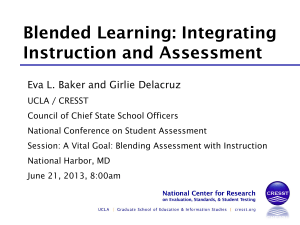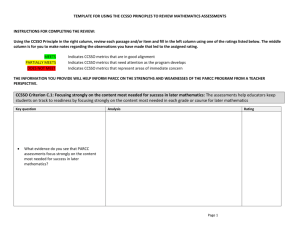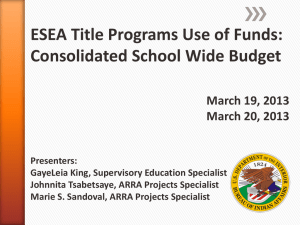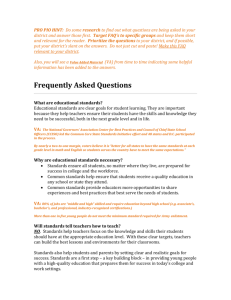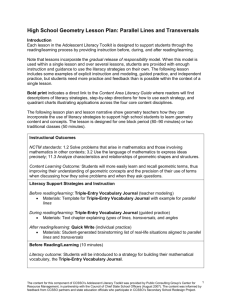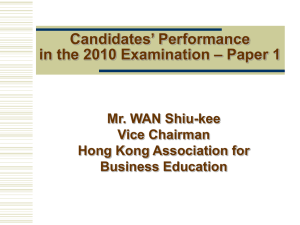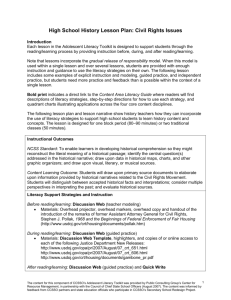December 9 Webinar Slide Deck - Council of Chief State School
advertisement
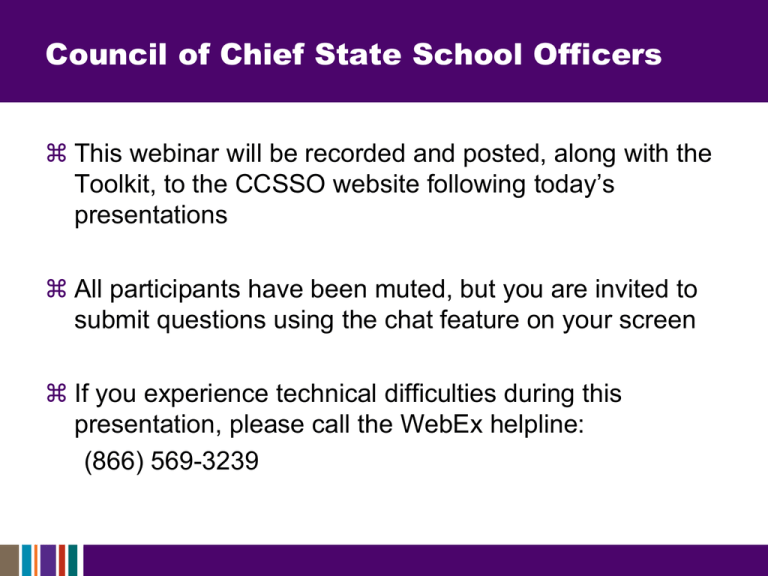
Council of Chief State School Officers This webinar will be recorded and posted, along with the Toolkit, to the CCSSO website following today’s presentations All participants have been muted, but you are invited to submit questions using the chat feature on your screen If you experience technical difficulties during this presentation, please call the WebEx helpline: (866) 569-3239 Maximizing Federal Funds Toolkit Peter Zamora (peter.zamora@ccsso.org) Director of Federal Relations CCSSO Federal Education Group Melissa Junge, Esq. Sheara Krvaric, Esq. Kathleen Airhart Deputy Commissioner Tennessee Department of Education David Blowman Deputy Secretary Delaware Department of Education Introduction to Toolkit Why this toolkit? Many states are not doing things they want to do because of concerns about the impact on federal funds/federal compliance requirements For example, many states want to: • Organize around policy priorities as opposed to funding source • Spend federal formula grants in ways that support state policy goals • Monitor not only for compliance but for program performance How does this toolkit help? Provides an overview of common misperceptions about federal programs that create implementation barriers Provides a roadmap for addressing those misperceptions 3 Changing the Status Quo is Hard Complicated federal rules lead to compliance myths and other challenges State power levers with regard to federal funds are “hidden” within complex regulatory language Past practice is powerful 4 Complicated Rules Impact Delivery Compliance myths: belief things are not permitted by federal law even when they are • Driver/example: confusion over supplement not supplant – BUT . . .rule is more flexible than typically perceived/differs by program Silo approach: initiatives administered on a federal funding stream basis rather than comprehensively • Driver/example: time and effort requirements – BUT . . . federal law offers some flexibility with regard to time and effort Significant resources (time and money) devoted to administrative requirements: numerous federal compliance requirements take up significant staff time/money (at federal, state, district, and school level) • Driver/example: duplicative planning, reporting, monitoring requirements – BUT . . . federal law permits certain planning to be consolidated 5 Toolkit Approach Sets up the problem and the challenge Recommends steps states can take to begin the work Identifies three broad areas where states can begin to rethink federal program implementation: 1. State use of funds policies 2. Planning and reporting requirements 3. Monitoring and oversight Suggests strategies and activities in each of these areas 6 First Area: State Use of Funds Policies Example of Opportunity: Supplement Not Supplant (SNS) Traditionally examined through the lens of three presumptions: 1. 2. 3. Is the activity required by state or local law? Was the activity previously supported with state/local funds? Do state/local funds support the same activity for other students? Yet, there are different SNS rules for different programs Title I schoolwide programs – different test IDEA, Part B – effectively no SNS just MOE Title II – no third presumption 7 Supplement not Supplant Example (cont.) State guidance may fail to highlight the different approaches to supplement not supplant, leading schools and districts (and their auditors) to apply more restrictive rules Opportunity: issuing guidance that clarifies the law and the available flexibilities 8 Second Area: Planning Requirements Example: Consolidated Application/Plans Federal law permits states to consolidate or combine applications/plans in certain circumstances Challenge is to maintain ability to trace back to federal compliance requirements and expectations Opportunity: taking an inventory of plans, then consolidating or combining plans in a way that reduces burden, increases focus, and reduces paperwork so that LEAs and schools can spend more time on instructional and student support activities 9 Third Area: Monitoring and Oversight Example: Monitoring Process Opportunity: reducing burden and increasing meaningfulness of monitoring and oversight work by embedding oversight throughout the grants process and taking a differentiated approach based on risk (including performance measures, spending data, etc.) 10 Rethinking Federal Processes at an SEA: Consolidated Planning and Monitoring Dr. Kathleen Airhart, Deputy Commissioner November 16, 2013 CCSSO Richmond, VA Increasing Rigor and Improving Outcomes for ALL Students Curriculum and Instruction Career and Technical Education Teachers and Leaders College & Career Readiness Consolidated Planning & Monitoring Special Populations CORE support 12 Office of Consolidated Planning & Monitoring Goal: To provide support to LEAs by aligning funding sources through a consolidated planning and monitoring process to incorporate a focus on outcomes for all students Better support districts to: Target ambitious goals around growth and gap closure Increase focus of spending plans on academic support Analyze and utilize all of available financial resources Streamline all aspects of monitoring and compliance Provide a clear connect between spending and student learning ePlan: Tennessee’s Planning and Monitoring tool Phased implementation Plan Planning Component: One electronic spending plan document providing information to include all revenues and directly linked to district accountability. Monitoring Component: Joint tiered monitoring combining ESEA and IDEA requirements and targeting those districts with the most significant challenges. Challenges to Implementation Reorganizing the SEA Supporting LEAs to plan comprehensively Shifting to results based-monitoring focus Targeting ESEA/IDEA compliance differentials Changing paradigms and breaking down barriers Providing consistency in messaging! Kathleen.Airhart@tn.gov 16 Delaware’s Move Toward Greater Flexibility with Stronger Accountability November 2013 17 Federal Funds: A Brief History Compliance focus as a result of federal monitoring findings Scope of Consolidated Application content increased dramatically Reduced focus on intent of “Consolidating” to reduce redundancy and increase coordination among programs Limited flexibility given to Schoolwide Schools due to misunderstanding of supplanting rules Untimely and sometimes inaccurate final allocations and significant delays in loading of funds Limited timeline for availability of funds One size fits all monitoring approach 18 School Year 13-14 Process Changes Centralized coordination and support for program managers to increase consistency of grant reviews Enhanced grant technical assistance to include clarity from program managers on grant expectations After providing technical assistance to LEAs provided full flexibility on use of funds for schoolwide schools Automated Title I allocations to reduce delays and eliminate errors Shortened timeframe for initial grant reviews by DOE Streamlined process of loading grant funds Gave LEAs full period of availability of funds Incorporated monitoring of quality for Title I, IDEA and ELLs into ESEA Flex routines Moved majority of compliance monitoring to desk audits 19 14-15 School Year and Beyond Enhanced technical assistance on strategic planning, with particular focus on conducting a quality needs assessment Stronger expectations on alignment of LEA/school defined needs, and needs discovered through data review during ESEA Flex monitoring routines, to the use of federal funds. Change focus of some consolidated application questions to hone in on quality rather than compliance Allow maximum flexibility for LEAs that are making progress Limiting allowable uses of funds for some LEAs that have not made progress with past uses of funds or where no alignment to needs exists (Ex. Title II and class size reduction) Greater coordination among program managers where there is overlap exists in grant questions (i.e. equitable services),Technical assistance, and fiscal monitoring Automating allocations for all other federal programs to further 20 reduce turnaround time for final allocations Questions? Please enter questions or comments in the chat box on your screen This webinar and the toolkit will be posted to www.ccsso.org States interested in learning more about the Federal Funds Working Group should contact CCSSO: Peter Zamora (peter.zamora@ccsso.org) Margaret Millar (margaret.millar@ccsso.org)
